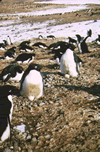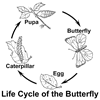Life cycle stages
The life cycle of all organisms usually involves some variation of each
of these stages:
- Mature adults produce gametes (sperm and eggs in animals; pollen
and ovules in flowering plants).

- In animals, adults attract a mate of the same species but opposite
sex using sounds (frog calls), scents (dogs on heat), visual appearance
(breeding plumage in birds), and courtship rituals (lyrebird dance,
sea gull displays). This ensures the fittest individuals breed at the
best time to aid survival of the species.
- Mating occurs to bring gametes together (pollination in flowers is
helped by insects, birds, and wind).
- Fertilisation of gametes occurs to form the zygote, the first cell
of the new individual. This may occur externally as in fish, or internally
in land animals as the sperm must swim to the eggs.
- The zygote starts dividing to form an embryo which continues to develop
(in shelled eggs, or internally inside the mother).

- Adults build a nest (or the female's womb develops) to protect developing
embryos.
- The young hatch from eggs, or are born.
- Parents protect the young and help development of survival skills
through learning and instinct.
- The young grow and develop to reproductive maturity.
Any long-term disruption of any stage can result in extinction.
Some life cycles studied in Primary Schools: Butterflies and frogs.
Butterflies
 This life cycle involves the adult male detecting a female by smell,
brief courtship display, and mating (sperm enters female and fertilises
eggs). The female lays eggs on a plant. The embryo develops into a caterpillar
using food stored in the egg. The caterpillar (larva) hatches, eats the
eggshell and then the plant. As it grows, it moults and grows new skin
several times to accommodate increased size. It increases in birth weight
by approximately 3000 times. Finally, it spins a cocoon in which the pupa
(chrysalis) changes drastically (metamorphosis) into the emerging adult
butterfly. The role of the short-lived adult is to fly to a new area,
mate and lay more eggs.
This life cycle involves the adult male detecting a female by smell,
brief courtship display, and mating (sperm enters female and fertilises
eggs). The female lays eggs on a plant. The embryo develops into a caterpillar
using food stored in the egg. The caterpillar (larva) hatches, eats the
eggshell and then the plant. As it grows, it moults and grows new skin
several times to accommodate increased size. It increases in birth weight
by approximately 3000 times. Finally, it spins a cocoon in which the pupa
(chrysalis) changes drastically (metamorphosis) into the emerging adult
butterfly. The role of the short-lived adult is to fly to a new area,
mate and lay more eggs.
Frogs
 Adult frogs locate and attract mates by "singing" a call
recognised only by that species. This prevents the loss of time, energy
and gametes in mating with other species resulting in no offspring.
Adult frogs locate and attract mates by "singing" a call
recognised only by that species. This prevents the loss of time, energy
and gametes in mating with other species resulting in no offspring.
| Copyright owned by the State of Victoria (Department of Education and Early Childhood Development). Used with Permission. |